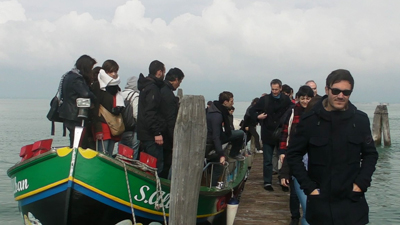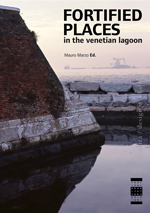You are in: Home page > Magazine Archive > Intensive teaching for the architectural project

Mauro Marzo
Intensive teaching for the architectural project
An international didactic experience
Abstract
This article outlines the experience of the Erasmus Intensive Programme
entitled "Fortified Places" which took place in three editions,
between April 2012 and February 2014, in Venice, Paris and Seville, and
investigates the project’s teaching method adopted in such initiative. The
discussions surrounding the projects took place at several different
intersecting levels: student-to-student, student-to-teacher,
teacher-to-teacher; and this greatly enhanced the exchange of information and
teaching methods. Given this modality, the transfer of knowledge, skills and
different points of view could occur both vertically (teacher - student) as
well as horizontally (student-student, teacher-teacher).
Premise
This article aims to bring forth certain considerations regarding the
international teaching experience of a recently completed architecture project.
The Erasmus Intensive Programme (EIP) about which I write, entitled “Fortified
Places”, was held in Venice, Paris and Seville, between April 2012 and and
February 2014. It included the participation of four schools of architecture: The Dipartimento di Culture del Progetto of the Università Iuav di
Venezia, which headed the project, the Departamento de Arquitectura
dell'Universidade da Évora (which participated only in the second and third
edition), l’École Nationale Supérieure d’Architecture Paris-Malaquais and the
Escuela Técnica Superior de Arquitectura – Universidad de Sevilla. The
scientific committee of the initiative was made up of: Joao Luis Carrilho da
Graça (Évora), Alberto Ferlenga (Venezia), Maria Salerno (Paris-Malaquais) and
Antonio Tejedor Cabrera (Siviglia).
This EIP was held within the “Lifelong Learning Programme”, which was financed by the European Community during the 2007-2013 quinquennial. The Community’s premise at the basis of the EIP consisted in the idea of experimenting a new approach to the Erasmus programme that was different than usual. Accustomed practice of the programme has individual students transferring to foreign University departments where they are to carry out a portion of their course of education, whereas the EIP involves a group of students and professors of different nationalities who are to convene for a given period of time at a selected university, where they are to coordinate an intensive learning experience based on a specific programme.
Following this explanation, there will be a description of the main objectives established by the “Fortified Places” EIP that highlights the more critical aspects of interest in the initiative with the purpose of contributing input to those who may wish to organize similar didactic initiatives in the future.
The “Fortified Places” didactic project set out to increase educational exchanges between those schools of architecture with which previous co-operative teaching activities have taken place (for example the “Villard” Itinerant Seminar for project design at Paris-Malaquais and the “Itálica: tiempo y paisaje” International Workshop in Seville). The positive results of these co-active collaborations led to the presentation of the EIP’s candidacy with the dual objective of establishing: a common ground for exchange among the different schools’ methodological approaches to the project of architecture, as well as preparing students to deal with the complexity of the proposed themes through trans-disciplinary approaches, as is increasingly requested in the current-day workplace.
It was starting with these initial courses of action that the structuring of the three EIP “Fortified Places” editions took place as veritable didactic laboratories for the convergence of multiple teaching approaches (architectural and landscape project design, history of the territory, photography and architectural restoration), for they were intended to define much more than a mere summary of notions in dealing with a realm of cross-disciplinary learning.
Project theme
The “Fortified Places” EIP aimed to set forth critical project-based reflections on the role of fortified places in the development of landscapes - both natural and urban - for their dual nature, as punctual elements as well as parts of a more ample system, especially for the potential that such places can offer in projects for the safeguard and overall valorisation of their surrounding territories. At a historic moment in which military functions in many European sites are left to abandon, the necessity for safeguard measures, valorisation and re-use of such places becomes increasingly evident for that which remains as impressive systems of military defence, made up of buildings dating back to historic or even more recent times.
The abandon of such imposing defence structures in fact constitutes an extraordinary opportunity for the restitution of a multiplicity of spaces that are not commonly accessible to the public. In organizing the EIP, a projectual experimentation was deemed necessary, even if only in didactic terms, to provide innovative interpretations of the possible role of military structures in certain regional territories.
The fortified sites, as a group, could in effect be seen as a constellation of places, like a system of buildings oftentimes of great worth and notable potential, or as an organised ensemble of defensive “machines” to be transformed into places for the education of history, and to be used as opportunities for the economic revival of the territories on which they stand.
The end decision was to deal with the study of the general theme of fortified places in three different European contexts, in attempting to imagine the military buildings as potential cornerstones for the definition of a series of project actions that would aim at improving the surrounding areas of those buildings.
The EIP hence proposed that students work on a specific theme - the recovery of military places that had either been abandoned or left to functions that were not appropriate given their historic value – in three very different contexts: the extremely delicate environmental balance of the Venetian Lagoon (2012), the spectacular building mass of the ocean-facing forts in Cadiz (2013), and the metropolitan context of Grand Paris (2014).
The teaching method
The methodological experiment carried out by the EIP consisted in having the students partake in a rapid approach to the project theme and the specificity of the given contexts, in just 17 days of workshop, through an intense dialogue among the participants for an effective exchange among the different disciplines involved. The workshop in fact sought to rely on the presence of distinguished figures with professional experience to encourage students to reflect on the need to converge the skills expressed by different professional fields into a synthesis of project-design.
With the completed experience, it was noted that the program took on the form of a real laboratory, in which teachers with different backgrounds held continuous discussions with the students, assigning the important role of knowledge of the places, as well as each place’s respective issues, to the project-design development.
Although short and intense, the course was divided into two phases of learning: the first consisted of a series of course-lessons, and the second in actual "research by design" project development.
The course-work had the characteristics of teaching activities aimed at building the necessary knowledge and skills to deal with the theme of fortified places as well as the specific qualities of the sites. Students were here able to benefit from the contribution of the academic professors involved, as well as the participation of government representatives of institutions and agency officials working for the protection and preservation of the areas’ architectural and landscape. The course-lessons were specifically geared towards creating a better understanding of the issues relating to the specificity of fortified places, and they were always followed by group discussions aimed at increasing the students' ability to interpolate the knowledge and experience transmitted, while critically selecting the relevant information to the project.
Although certainly not unprecedented, the most innovative aspect of the workshop consisted in the fact that the students proceeded to form mixed groups (French, Italian, Portuguese and Spanish) immediately following the survey visits to the project areas. Each group drew up its own project independently, deliberately avoiding assigning the responsibility of their project to a single professor.
On the contrary, the professors, who also came from different school backgrounds and nationalities, held discussions together with the various student groups, highlighting the strengths and weaknesses of each project-design strategy. Therefore, the discussions surrounding the projects took place at several different intersecting levels: student-to-student, student-to-teacher, teacher-to-teacher; and this greatly enhanced the exchange of information and points of view. Given this modality, a transmission of knowledge took place, not only through class-room style lessons, but also through dialogue and induction, ensuring that the transfer of knowledge could occur both vertically (teacher - student) as well as horizontally (student-student, teacher-teacher).
It is precisely at this stage of the project development that the workshop perhaps best achieved its results since the students demonstrated such a strong capability for discussion and exchange, as well as a notable inclination towards a hybridization and contamination of their respective viewpoints for project-design.
Conversely, in observing the project outcomes of the three workshops (the results of the first two editions of the EIP being published in M. Marzo, ed. by, Fortified Places in the Venetian Lagoon, 2012 and A. Tejedor , M. Linares , ed. by, Fortified Places in the Bay of Cadiz, while the third volume on the workshop regarding the fortifications of the "Grand Paris" is to be published in 2014), one may note how the mixed composition of the groups and the absence of a sole professor responsible for each group has led to the emergence of excessive intermingling among the projects and a weakening of distinct differences among the architectural styles and approaches.
However, in going beyond this critical issue, to verify the usefulness of this "intensive" teaching program in the education of students, it is important to stress that the question of fortified places and the specific qualities of the identified case-studies led students to test their capacities at working under very tight schedules while keeping control of the different scales of the project. In addition, they had to seriously reflect on the relationship between architecture developed for purposes of defence and the newly emerging demands that require the development of entirely new roles for that architecture; ones that are also in line with the historical/constructive character for those buildings.
And finally, in asking oneself if such an "intensive" immersion into a teaching project has also yielded an enrichment for the teachers, it should be pointed out that the workshop has generated at least three outcomes of some interest: the activation of an international exchange of different methodologies of approach to project-design for areas characterized by pre-existing military structures; the definition of an articulated course of education in which different disciplines are brought together; and finally the testing of a teaching method for a workshop where students and teachers alike can benefit from the exchange and the possible hybridization of the traditions in project-design that each and every school carries.
Mauro Marzo is assistant professor in Architectural and Urban Composition at the Università Iuav di Venezia and member of the board of the curriculum in Architectural Composition at Iuav Doctoral School.
Bibliography
Marzo, M. (2012). Fortified Places in the Venetian Lagoon. Parma: Festival Architettura Edizioni.
Tejedor Cabrera, A., Linares Gómez del Pulgar (2013). Fortified Places in the Bay of Cadiz. Parma: Festival Architettura Edizioni.
Webliography
http://www.iuav.it/fortifiedplaces
fortifiedplaces.us.es
http://ensapm.wix.com/fortifiedplacesparis















